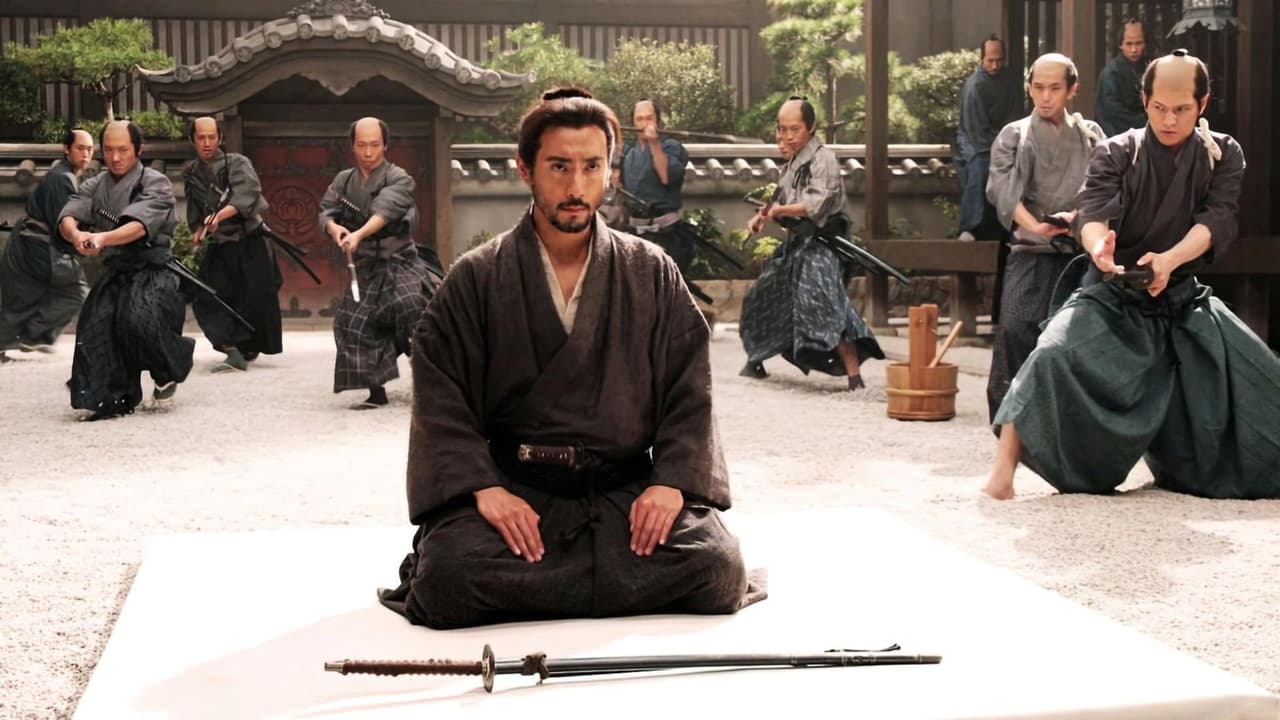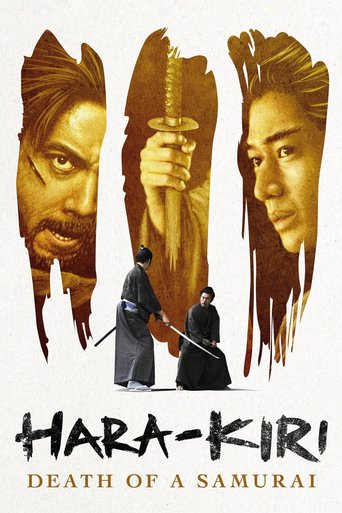

That was an excellent one.
... View MoreGood start, but then it gets ruined
... View MoreBeautiful, moving film.
... View MoreExcellent and certainly provocative... If nothing else, the film is a real conversation starter.
... View MoreIn seventeenth Century Japan it is a time of relative peace and samurai who were in service to defeated warlords have fallen on hard times. One, Hanshiro, goes to the local castle asking if he me commit hara-kiri, ritual suicide, in the castle courtyard. Before granting permission he is told the story of Motome, another poor samurai from the same clan as Hanshiro, who made a similar request a year before. Several others had made similar requests but changed their minds when offered money; suspecting Motome is another 'suicide bluffer' they decide to make an example of him and force him to go ahead with his suicide; even after he begs for three ryo for his sick wife, Miho, and child not only that he must use his wooden bladed sword. This is slow and agonising. We then learn that Hanshiro not only knew Motome but is his father in-law and now he wants revenge. In flashback we then see Hanshiro and Motome's past and how the latter became so desperate. We then return to Hanshiro's present for the inevitably tragic conclusion.I have yet to see the original film so can't say how this compares. Judging it on its own I can say I really enjoyed it even if it was far from the 'samurai action film' I'd expected. The scene where Motome is forced to disembowel himself with a wooden sword is painfully gruelling to watch as it goes on and on even though it doesn't dwell on the wounds inflicted it is a hard watch; and rightly so. When we learn of his connection to Hanshiro that painful scene explains why he is so desperate to show how a real samurai lives and dies. The cast does a fine job; most notably Ebizô Ichikawa, Eita and Hikari Mitsushima as Hanshiro, Motome and Miho respectively. Takashi Miike's direction is impressively subtle given his reputation over-the-top violence. Overall I'd recommend this; just don't expect lots of action; this is about character.
... View MoreHARA-KIRI: DEATH OF A SAMURAI is Takashi Miike's follow-up to the crowd-pleasing, SEVEN SAMURAI-alike, 13 ASSASSINS. This film is a whole different kettle of fish entirely and it's almost as if Miike went deliberately out of his way to make an anti-13 ASSASSINS; there's no action here, none of the wonderfully choreographed fight scenes that made his previous film such a smash.Instead, HARA-KIRI is an intense and emotional drama that explores notions of honour, familial ties and duty, packaging it in such a way that makes it a unique movie. As with most Miike, it's a sometimes obscure, often unwieldy production, deliberately going out of its way to be as slow-paced as possible and letting the story unfold in real time. Flashbacks are used extensively and those looking for an explosive, revenge-fuelled drama would do well to seek elsewhere as this isn't satisfying in that way at all.Instead, it's a unique beast. The first 30 minutes is completely horrifying, a grisly ordeal that nearly manages to outdo PASSION OF THE Christ in its depiction of on screen suffering and pain. The rest of the film is a slow burner, although it does build up to an effective climax of sorts. The actors are well accomplished, with the excellent Ebizo Ichikawa holding the fort for much of the time. Needless to say, the level of technical proficiency is high and the film as a whole is expertly made; the intense drama of the characters' ordeals makes it one of Miike's most mature works yet.
... View MoreThis is my first Miike film, as I am not a fan of the general themes and stories that he tells. Kobayashi's original, with legendary actor Nakadai, is a shining example of ironic storytelling in the "jidai-geki" (essentially historical fiction) mode. "Jidai-geki", where it uses swordplay, is characterized by short flashes of action as opposed to "chambara" (swordplay) or "samurai slasher" flicks which are all about the action and blood (usually copious amounts of it). I notice a number of the reviewers do not know or appreciate the distinction.The original's purposes were multiple but most critics center in on the irony of the red armor, which to the casual observer would seem to show the dedication of the house of Ii to honor through the samurai arts. The film shows this to be an empty shell in many ways. It's the delightful sense of irony in all aspects of the storytelling that makes Hara-Kiri (1962) such a delicious film. Take, for example, the story of seppuku told by the high official to Hanshiro. In the original, when the official tells the ronin of the wooden swords, the ronin pulls out his own sword from its sheath briefly to show it is steel. This contrasts with his son-in-law's action, but also with the house of Ii, who talk a good game, but when push comes to shove, do not suit their words to action. Miike chooses to substitute a different irony by having Hanshiro use a wooden sword at the end. This leads to some interesting things. For instance, the best swordsman of the house of Ii present is soundly beaten in his dual with a classic basic technique of a strike to the head (in "kendo", "men") with a wooden sword. This in turn invokes the dual between Musashi Miyamoto and Sasaki wherein Musashi used a wooden sword and killed his opponent, i.e. Hanshiro is a much better warrior (skilled swordsman) than the empty Ii but also better warrior (honorable samurai). It's not that these new ironies are not fun, but the original's use of timing and quick reveals (e.g. the topnots) does so both more efficiently than the gradual reveals of Miike here but more importantly gets Kobayashi's point across more effectively.Of course in 1962 the wonderful realism and nitty gritty of daily life made popular by Yamada's trilogy of adaptions of Fujisawa's written work (Twilight Samurai, The Hidden Blade, Love and Honor) hadn't happened yet, and so Miike's adaption has something to offer the previous incarnation did not have, but is that trade-off worth the price in this case? Certainly the darker lighting and more muted colors in set design and costuming gave Miike a chance to be more artistic (his shocking use of color in brief autumn scenes and the use of the white cat). Still his desire to create some sympathetic elements in the antagonists (e.g. the official's giving 3 ryo and cutting off Motome's head himself) needlessly waters down the problem with the house of Ii. Other reviews have said that Miike favors ambiguity, but here it's not enough to really create sympathy for the noble house. He should have done either more in fleshing out the character of the head official or less and made the message clearer. It comes across as half-hearted here, when the point is to show in both versions that the honor of the house is lacking.Don't get me wrong, Miike has made a fine attempt in the new style of jidai-geki, one that apparently contrasts with his usually more exploitational style, it's just not as good as getting to its point as the original.
... View MoreMiike remade "13 Assassins" to take full advantage of technical advances since the original arrived in the early '60s. Thus it was more spectacular, a great battle movie that put us in the heart of slash-pierce-hack-crunch-and-filet combat.. Of its kind, it was great and the update made sense. The same cannot be said for his remake of the Kobayashi masterpiece, which was intimate, a rumination on the cruelty and hypocrisy of bushido. A nutshell: an impoverished older samurai comes to a great house seeking a place to commit hara-kiri: he's told a young man tried the same trick earlier, a "bluff" suicide, hoping to get money or a job. But the House forced him to live up to his word, even though he'd sold his swords: thus he committed seppuku with wooden blades. It turns out that the older man is the younger's father in law: he's come for vengeance on the house, and (spoiler) after revealing he's defeated the young man's three primary adversaries in single combat, he draws blade on the house and goes down in a bloody frenzy of vengeance. Great revenge movie, but Miike rewires it. You'd expect him to lay on the gore (as he did in "13" and many of his quickie yakuza films) but instead he dials it way down, keeps it somehow intellectual rather than visceral. Sorry, but I'm shallow enough to be disappointed: I wanted to see heads roll and arms chopped off. (It's a SAMURAI movie, right?) He retains Kobayashi's deliberate, almost ritual like pace and symmetrical compositions, but the understated intensity (SPOILER!: the old man fights his last fight with the wooden sword, so he is incapable of killing the Household guard) of the climax lets the movie end without the emotional catharsis it demanded. A disappointing exercise.
... View More